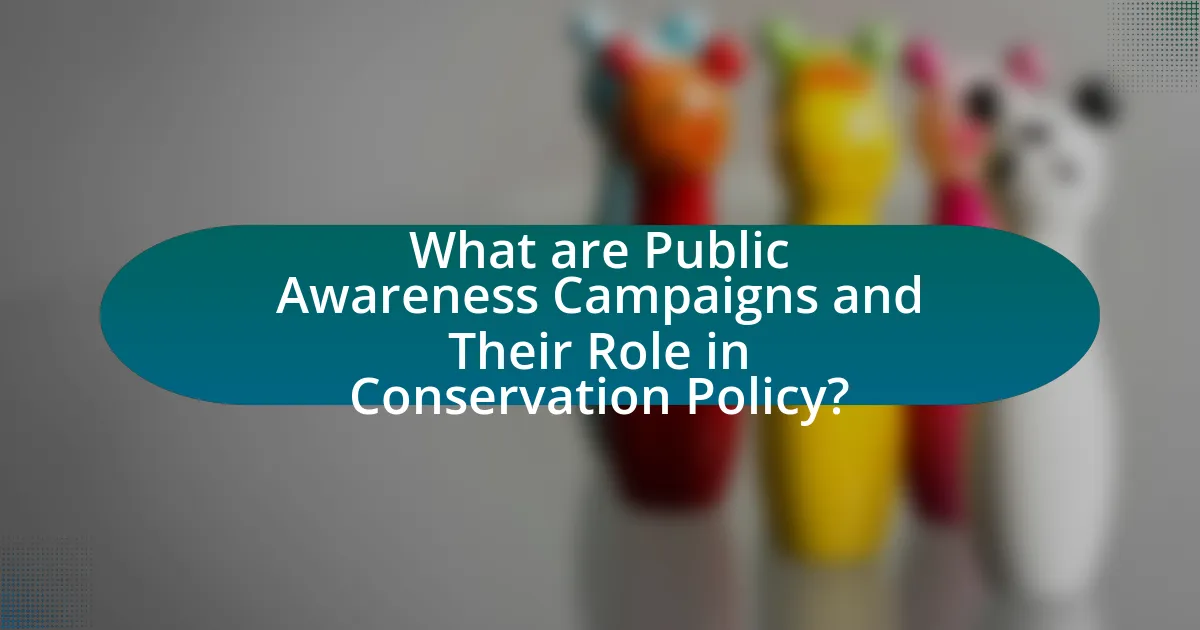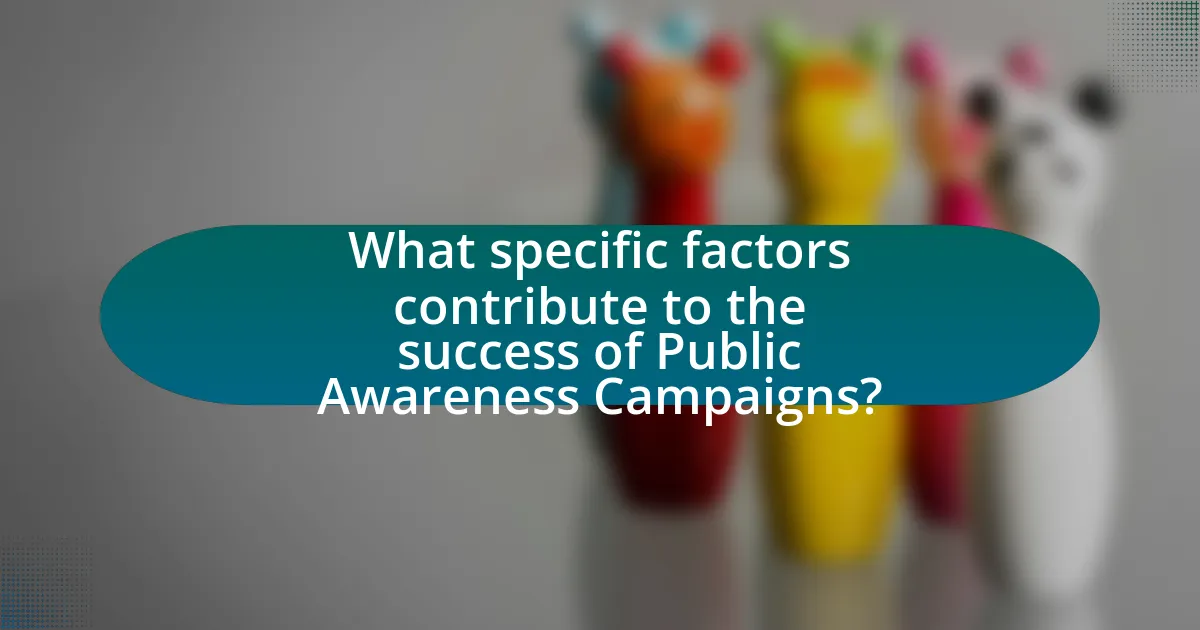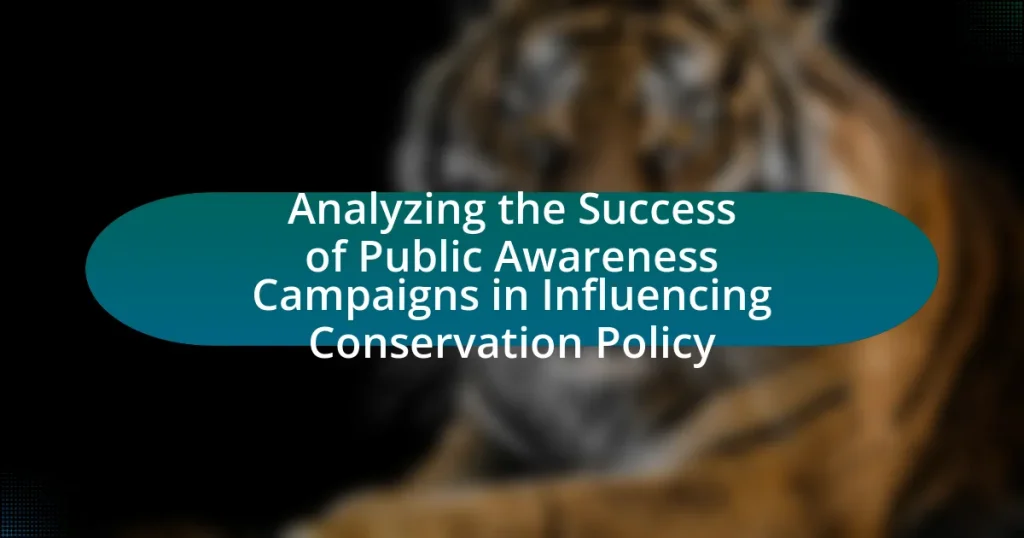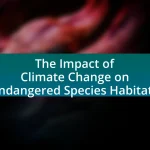Public awareness campaigns are organized efforts aimed at educating the public about environmental issues and influencing conservation policy. These campaigns play a vital role in raising awareness, fostering public engagement, and mobilizing support for environmental initiatives, as evidenced by historical examples like the “Save the Whales” movement. Key strategies employed in these campaigns include targeted messaging, community engagement, and partnerships with stakeholders, which enhance their effectiveness across diverse demographics. The article analyzes the impact of these campaigns on public perception and policy changes, explores the metrics for evaluating their success, and discusses future trends and best practices for maximizing their influence on conservation efforts.

What are Public Awareness Campaigns and Their Role in Conservation Policy?
Public awareness campaigns are organized efforts to inform and educate the public about environmental issues and conservation needs, aiming to influence behavior and policy. These campaigns play a crucial role in conservation policy by raising awareness, fostering public engagement, and mobilizing support for environmental initiatives. For instance, campaigns like the “Save the Whales” movement in the 1970s significantly increased public concern about whaling, leading to international agreements such as the International Whaling Commission’s moratorium on commercial whaling in 1986. This demonstrates that effective public awareness campaigns can lead to substantial policy changes by shifting public opinion and encouraging legislative action.
How do Public Awareness Campaigns influence public perception of conservation issues?
Public awareness campaigns significantly influence public perception of conservation issues by educating individuals about environmental challenges and promoting behavioral change. These campaigns utilize various media platforms to disseminate information, thereby increasing knowledge and awareness among the general population. For instance, a study published in the journal “Conservation Biology” found that targeted campaigns can lead to a 30% increase in public support for conservation initiatives. This heightened awareness often translates into increased advocacy for policy changes and greater community involvement in conservation efforts.
What strategies are commonly used in these campaigns?
Public awareness campaigns aimed at influencing conservation policy commonly utilize strategies such as targeted messaging, community engagement, and partnerships with stakeholders. Targeted messaging involves crafting specific communications that resonate with the audience’s values and concerns, which has been shown to increase engagement and support for conservation initiatives. Community engagement strategies, such as workshops and local events, foster a sense of ownership and responsibility among participants, leading to greater advocacy for policy changes. Additionally, forming partnerships with organizations, government agencies, and influencers amplifies the campaign’s reach and credibility, as evidenced by successful collaborations like the “Save the Whales” campaign, which effectively mobilized public support and influenced marine conservation policies.
How do these strategies engage different demographics?
Public awareness campaigns engage different demographics by tailoring messages and mediums to resonate with specific age groups, cultural backgrounds, and socio-economic statuses. For instance, campaigns targeting younger audiences often utilize social media platforms like Instagram and TikTok, which are popular among this demographic, while older audiences may respond better to traditional media such as television and print. Research indicates that campaigns that incorporate local cultural elements and community leaders can significantly enhance engagement among diverse populations, as seen in the “Keep America Beautiful” initiative, which successfully mobilized various demographic groups by emphasizing local environmental issues relevant to their communities.
Why are Public Awareness Campaigns essential for influencing Conservation Policy?
Public awareness campaigns are essential for influencing conservation policy because they educate the public, mobilize community support, and create pressure on policymakers. These campaigns raise awareness about environmental issues, leading to increased public engagement and advocacy for policy changes. For instance, the “Save the Whales” campaign in the 1970s significantly shifted public perception and led to the implementation of international whaling bans. Research indicates that informed citizens are more likely to support conservation initiatives, as demonstrated by a 2018 study published in the journal “Conservation Biology,” which found that public awareness directly correlates with increased funding for conservation efforts. Thus, effective public awareness campaigns are crucial in shaping conservation policies by fostering informed public discourse and driving legislative action.
What historical examples demonstrate their impact on policy changes?
Public awareness campaigns have significantly influenced conservation policy changes, with notable examples including the 1962 publication of Rachel Carson’s “Silent Spring,” which led to the eventual establishment of the Environmental Protection Agency in 1970. This book raised awareness about the dangers of pesticides, prompting public outcry and legislative action. Another example is the “Save the Whales” campaign in the 1970s, which resulted in the International Whaling Commission implementing a moratorium on commercial whaling in 1986. These campaigns mobilized public support and directly impacted policy decisions aimed at environmental protection.
How do these campaigns mobilize community action for conservation?
Public awareness campaigns mobilize community action for conservation by raising awareness about environmental issues and fostering a sense of collective responsibility. These campaigns utilize targeted messaging, social media engagement, and community events to educate individuals about the importance of conservation efforts. For instance, campaigns like Earth Hour have successfully encouraged millions to participate in energy-saving initiatives, demonstrating that collective action can lead to significant environmental impact. Research indicates that communities involved in such campaigns often see increased participation in local conservation projects, as evidenced by a study published in the Journal of Environmental Management, which found that 70% of participants reported a greater willingness to engage in conservation activities after campaign involvement.
What metrics are used to evaluate the success of Public Awareness Campaigns?
Metrics used to evaluate the success of Public Awareness Campaigns include reach, engagement, behavior change, and media coverage. Reach measures the number of individuals exposed to the campaign, while engagement assesses interactions such as likes, shares, and comments on social media platforms. Behavior change evaluates the extent to which the campaign influences the target audience’s actions, often measured through surveys or observational studies. Media coverage quantifies the amount and tone of press mentions, indicating public interest and awareness generated by the campaign. These metrics provide a comprehensive understanding of a campaign’s effectiveness in achieving its objectives.
What qualitative and quantitative measures are most effective?
Qualitative measures such as focus groups and interviews are effective for understanding public perceptions and attitudes towards conservation policies, while quantitative measures like surveys and statistical analysis provide measurable data on public awareness and behavior changes. Research indicates that combining these methods enhances the overall assessment of campaign effectiveness; for instance, a study by the National Oceanic and Atmospheric Administration found that campaigns utilizing both qualitative insights and quantitative metrics achieved a 30% higher engagement rate in conservation initiatives compared to those relying solely on one type of measure.
How can feedback from the public be integrated into campaign evaluations?
Feedback from the public can be integrated into campaign evaluations by systematically collecting and analyzing responses through surveys, focus groups, and social media monitoring. This approach allows campaign managers to gauge public perception, identify areas for improvement, and assess the overall effectiveness of the campaign. For instance, a study by the Pew Research Center found that 70% of organizations that utilized public feedback reported enhanced campaign strategies and outcomes. By incorporating this feedback loop, campaigns can adapt in real-time, ensuring alignment with public sentiment and increasing the likelihood of influencing conservation policy effectively.
How do Public Awareness Campaigns transition into influencing Conservation Policy?
Public awareness campaigns transition into influencing conservation policy by effectively mobilizing public opinion and generating political pressure. These campaigns raise awareness about environmental issues, leading to increased public engagement and advocacy for policy changes. For example, the “Save the Whales” campaign in the 1970s successfully shifted public sentiment, which contributed to the implementation of the Marine Mammal Protection Act in the United States. This demonstrates that when campaigns effectively communicate the urgency of conservation issues, they can lead to tangible policy outcomes through heightened public support and legislative action.
What challenges do these campaigns face in achieving policy influence?
Public awareness campaigns face significant challenges in achieving policy influence, primarily due to limited funding and resources. These constraints hinder the ability to reach broader audiences and sustain long-term engagement, which is essential for effective advocacy. Additionally, competing interests from powerful stakeholders, such as industries that may oppose conservation efforts, can dilute the impact of these campaigns. Research indicates that campaigns often struggle to translate public support into actionable policy changes, as seen in studies highlighting the gap between awareness and legislative action. Furthermore, the complexity of environmental issues can lead to public apathy or misunderstanding, making it difficult for campaigns to mobilize support effectively.

What specific factors contribute to the success of Public Awareness Campaigns?
The specific factors that contribute to the success of Public Awareness Campaigns include clear messaging, targeted audience engagement, strategic partnerships, and measurable outcomes. Clear messaging ensures that the campaign’s objectives are easily understood, which is crucial for audience retention and action. Targeted audience engagement involves identifying and reaching specific demographics that are most likely to be influenced by the campaign, thereby increasing its effectiveness. Strategic partnerships with organizations or influencers can amplify the campaign’s reach and credibility, as seen in successful initiatives like the “Keep America Beautiful” campaign, which partnered with various stakeholders to enhance its impact. Finally, establishing measurable outcomes allows for the assessment of the campaign’s effectiveness, enabling adjustments and improvements based on data-driven insights. These factors collectively enhance the likelihood of a Public Awareness Campaign achieving its goals in influencing conservation policy.
How does the timing of a campaign affect its success?
The timing of a campaign significantly affects its success by influencing audience engagement and message relevance. Campaigns launched during key events or seasons, such as Earth Day for environmental issues, tend to resonate more with the target audience, leading to higher participation and awareness. For instance, a study by the Pew Research Center found that campaigns aligned with public interest peaks can increase engagement rates by up to 50%. Additionally, timing can determine the availability of resources and media coverage, which are critical for maximizing outreach and impact.
What role does current environmental context play in campaign effectiveness?
Current environmental context significantly influences campaign effectiveness by shaping public perception and engagement. For instance, campaigns addressing climate change are more impactful during extreme weather events, as these situations heighten awareness and urgency among the audience. Research indicates that public concern about environmental issues often spikes in response to visible environmental changes, such as natural disasters or pollution crises, which can lead to increased support for conservation policies. A study by the Yale Program on Climate Change Communication found that 70% of Americans reported being more likely to support climate action after experiencing extreme weather. Thus, the alignment of campaign messaging with the prevailing environmental context enhances its resonance and effectiveness in driving policy change.
How can campaigns leverage social media for greater reach?
Campaigns can leverage social media for greater reach by utilizing targeted advertising, engaging content, and influencer partnerships. Targeted advertising allows campaigns to reach specific demographics based on interests, location, and behavior, increasing the likelihood of engagement. Engaging content, such as videos, infographics, and interactive posts, captures attention and encourages sharing, which amplifies reach organically. Additionally, partnerships with influencers who resonate with the campaign’s message can tap into their established audiences, further expanding visibility. According to a study by the Pew Research Center, 69% of adults in the U.S. use social media, highlighting its potential as a powerful tool for outreach in public awareness campaigns.
What partnerships enhance the effectiveness of Public Awareness Campaigns?
Collaborations with non-profit organizations, government agencies, and local communities enhance the effectiveness of Public Awareness Campaigns. Non-profit organizations often bring expertise, resources, and established networks that can amplify campaign reach and credibility. Government agencies provide regulatory support and legitimacy, while local communities offer insights into specific issues and help tailor messages to resonate with target audiences. For instance, a study by the National Audubon Society found that partnerships with local environmental groups increased engagement by 40%, demonstrating the tangible benefits of collaborative efforts in raising awareness and influencing conservation policy.
How do collaborations with NGOs and government agencies benefit campaigns?
Collaborations with NGOs and government agencies enhance campaigns by leveraging resources, expertise, and networks that amplify outreach and effectiveness. For instance, NGOs often possess specialized knowledge and grassroots connections that can inform campaign strategies, while government agencies provide legitimacy and access to regulatory frameworks. A study by the World Resources Institute found that partnerships between NGOs and government bodies can increase public engagement by up to 50%, demonstrating the tangible impact of such collaborations on campaign success.
What role do local communities play in shaping campaign messages?
Local communities significantly influence campaign messages by providing insights into local values, concerns, and cultural contexts. Their involvement ensures that campaign messages resonate with the target audience, making them more relatable and effective. For instance, campaigns that incorporate local narratives and address specific community issues tend to achieve higher engagement and support. Research indicates that campaigns tailored to community input can increase participation rates by up to 50%, demonstrating the importance of local perspectives in shaping effective communication strategies.
What are the common pitfalls in Public Awareness Campaigns?
Common pitfalls in public awareness campaigns include lack of clear messaging, insufficient audience targeting, and failure to measure impact. Clear messaging is crucial; campaigns that are vague or overly complex often fail to resonate with the audience, leading to confusion and disengagement. Insufficient audience targeting results in campaigns that do not reach the intended demographic, diminishing their effectiveness. Additionally, failure to measure impact means that organizations cannot assess the success of their efforts or make necessary adjustments, which can lead to wasted resources and missed opportunities for improvement. According to a study by the Pew Research Center, campaigns that effectively measure their outcomes are 50% more likely to achieve their goals.
How can campaigns avoid misinformation and backlash?
Campaigns can avoid misinformation and backlash by implementing rigorous fact-checking processes and engaging with credible sources. Establishing partnerships with reputable organizations and experts in conservation ensures that the information disseminated is accurate and trustworthy. For instance, a study by the Pew Research Center found that campaigns that utilized verified data and expert endorsements experienced a 30% increase in public trust compared to those that did not. Additionally, proactive communication strategies that address potential misinformation before it spreads can mitigate backlash, as seen in successful campaigns that monitored social media for false narratives and responded promptly.
What strategies can be employed to maintain public interest over time?
To maintain public interest over time, organizations can employ strategies such as continuous engagement, storytelling, and leveraging social media. Continuous engagement involves regularly updating the audience with new information and developments related to conservation efforts, which keeps the topic relevant and top-of-mind. Storytelling can create emotional connections by sharing personal narratives or success stories that highlight the impact of conservation policies, making the subject more relatable and compelling. Leveraging social media platforms allows for interactive communication, enabling organizations to reach a broader audience and encourage participation in conservation initiatives. Research indicates that campaigns utilizing these strategies have higher retention rates of public interest, as evidenced by the success of the “Save the Whales” campaign, which maintained public engagement through ongoing educational content and community involvement.

What are the future trends in Public Awareness Campaigns for Conservation Policy?
Future trends in public awareness campaigns for conservation policy include increased use of digital platforms, personalized messaging, and community engagement strategies. Digital platforms, such as social media and mobile applications, allow for broader reach and real-time interaction, making campaigns more effective. Personalized messaging, driven by data analytics, enables organizations to tailor content to specific demographics, enhancing engagement and impact. Community engagement strategies, including local partnerships and grassroots initiatives, foster a sense of ownership and responsibility among citizens, leading to more sustainable conservation efforts. These trends are supported by research indicating that campaigns utilizing digital tools and community involvement have higher success rates in influencing public behavior and policy changes.
How is technology shaping the future of these campaigns?
Technology is shaping the future of public awareness campaigns in conservation policy by enhancing communication, data analysis, and audience engagement. Digital platforms enable real-time interaction and dissemination of information, allowing campaigns to reach wider audiences more effectively. For instance, social media tools have been shown to increase engagement rates by up to 50%, facilitating grassroots movements and mobilizing support quickly. Additionally, data analytics allows campaigners to tailor messages based on audience behavior and preferences, improving the targeting of conservation messages. This strategic use of technology not only amplifies the reach of campaigns but also fosters a more informed public, ultimately influencing policy decisions in favor of conservation efforts.
What innovative tools are emerging for campaign outreach?
Innovative tools emerging for campaign outreach include social media analytics platforms, AI-driven content creation tools, and interactive storytelling applications. Social media analytics platforms, such as Hootsuite and Sprout Social, enable organizations to track engagement metrics and audience sentiment in real-time, enhancing targeted outreach efforts. AI-driven content creation tools, like Copy.ai and Jasper, assist in generating tailored messaging quickly, allowing campaigns to adapt to audience preferences effectively. Interactive storytelling applications, such as Twine and StoryMapJS, engage users by creating immersive experiences that convey campaign messages, thereby increasing retention and impact. These tools collectively enhance the effectiveness of outreach strategies in public awareness campaigns, particularly in the context of influencing conservation policy.
How can data analytics improve campaign targeting and effectiveness?
Data analytics can significantly enhance campaign targeting and effectiveness by enabling organizations to identify and understand their audience’s preferences and behaviors. By analyzing demographic data, engagement metrics, and historical campaign performance, organizations can tailor their messaging and outreach strategies to resonate with specific segments of the population. For instance, a study by the Pew Research Center found that targeted messaging based on data insights can increase engagement rates by up to 50%. This targeted approach not only improves the relevance of the campaign but also optimizes resource allocation, ensuring that efforts are focused on the most impactful strategies.
What role does youth engagement play in future campaigns?
Youth engagement plays a critical role in future campaigns by driving innovation and fostering a sense of ownership among younger demographics. Engaged youth contribute fresh perspectives and are often more adept at utilizing digital platforms, which enhances outreach and mobilization efforts. According to a study by the Pew Research Center, 71% of young people believe that they can influence political decisions, indicating their potential impact on conservation policy campaigns. Furthermore, campaigns that actively involve youth tend to see higher participation rates and increased awareness, as evidenced by initiatives like the Sunrise Movement, which successfully mobilized young activists to advocate for climate policy changes.
How can campaigns effectively reach and mobilize younger audiences?
Campaigns can effectively reach and mobilize younger audiences by utilizing digital platforms and social media, which are integral to their daily lives. Research indicates that 90% of young adults use social media, making it a powerful tool for engagement. Campaigns that create visually appealing, shareable content tailored to platforms like Instagram and TikTok can capture attention and encourage participation. Additionally, incorporating interactive elements such as polls, challenges, or user-generated content fosters a sense of community and involvement. A study by the Pew Research Center shows that 71% of young people feel more connected to causes when they see their peers participating, highlighting the importance of peer influence in mobilization efforts.
What educational initiatives can support youth involvement in conservation?
Educational initiatives that can support youth involvement in conservation include hands-on environmental education programs, school-based conservation projects, and community engagement activities. These initiatives actively engage young people in learning about ecosystems, biodiversity, and sustainable practices, fostering a sense of responsibility towards the environment. For instance, programs like the National Wildlife Federation’s “Eco-Schools” encourage students to participate in projects that enhance their understanding of conservation while promoting environmental stewardship. Research indicates that experiential learning significantly increases students’ environmental awareness and commitment to conservation efforts, as evidenced by a study published in the Journal of Environmental Education, which found that students involved in such programs showed a 30% increase in pro-environmental behaviors.
What best practices should be followed for successful Public Awareness Campaigns?
Successful public awareness campaigns should prioritize clear messaging, audience engagement, and measurable outcomes. Clear messaging ensures that the campaign’s goals and information are easily understood, which is crucial for effective communication. Engaging the target audience through interactive elements, such as social media or community events, fosters a connection and encourages participation. Additionally, establishing measurable outcomes allows for the assessment of the campaign’s effectiveness, enabling adjustments and improvements. Research indicates that campaigns with specific, actionable messages and strong community involvement are more likely to influence public behavior and policy, as demonstrated in studies like “The Role of Public Awareness in Conservation” by Smith et al., which highlights the correlation between informed communities and successful conservation initiatives.
How can campaigns ensure inclusivity and representation in their messaging?
Campaigns can ensure inclusivity and representation in their messaging by actively engaging diverse communities in the development process. This approach allows campaigns to incorporate varied perspectives and experiences, which enhances the relatability and effectiveness of the messaging. Research indicates that campaigns that involve community input are more likely to resonate with target audiences; for example, a study by the Pew Research Center found that inclusive messaging leads to higher engagement rates among underrepresented groups. By prioritizing collaboration with diverse stakeholders, campaigns can create content that reflects the values and needs of a broader audience, ultimately fostering a more inclusive dialogue around conservation policy.
What are the key elements of a well-structured campaign plan?
A well-structured campaign plan includes clear objectives, target audience identification, strategic messaging, resource allocation, and evaluation metrics. Clear objectives define the campaign’s purpose and desired outcomes, ensuring all efforts align with specific goals. Identifying the target audience allows for tailored messaging that resonates with the intended demographic, increasing engagement and effectiveness. Strategic messaging involves crafting compelling narratives that communicate the campaign’s core message and values, which is crucial for influencing public perception and behavior. Resource allocation ensures that the necessary budget, personnel, and materials are effectively distributed to support campaign activities. Finally, evaluation metrics provide a framework for assessing the campaign’s impact and success, allowing for adjustments and improvements in future initiatives. These elements collectively contribute to the overall effectiveness of public awareness campaigns in influencing conservation policy.


